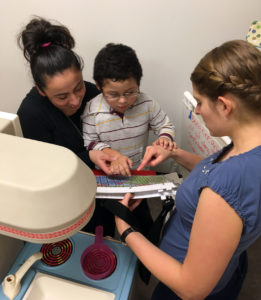Alex’s Story
 When five-year old Alex arrives at Children’s Therapy Center for his weekly speech-language and feeding therapy session, he can hardly contain his excitement. Diagnosed with Autism Spectrum Disorder (ASD), Alex received both occupational and speech-language therapy through Early Support for Infants and Toddlers (ESIT), a program specifically designed for children age birth to three. However, like many children with ASD, his symptoms didn’t simply disappear after his third birthday.
When five-year old Alex arrives at Children’s Therapy Center for his weekly speech-language and feeding therapy session, he can hardly contain his excitement. Diagnosed with Autism Spectrum Disorder (ASD), Alex received both occupational and speech-language therapy through Early Support for Infants and Toddlers (ESIT), a program specifically designed for children age birth to three. However, like many children with ASD, his symptoms didn’t simply disappear after his third birthday.
“Our pediatrician recommended that he continue to receive therapy,” says Maria. “He gave us a list of places to call but most were too far away and hard to get to by bus – we don’t have a car. Children’s Therapy Center is in our neighborhood. We can walk here, which is so helpful!”
Alex leads the way to the feeding room, where today Erin will work on helping Alex accept new and different foods into his diet. Alex has very specific likes and dislikes when it comes to food. The list of welcomed food includes yogurt, bananas, Oreo cookies, rice, Mexican pasta, soup, Mexican bread, and Lay’s potato chips. He has recently tried apples and – at least for now – finds them acceptable, although Maria acknowledges that might change with no warning.
Alex reaches for his picture communication book, a red notebook filled with pictures that his mother made for him. He uses the pictures included in the book to help him identify what he will try to eat for lunch today.
“Alex is learning how to communicate vocally but in the meantime he uses pictures, which really help him convey his feelings and manage his emotions,” Erin explains. “Without a reliable, effective way to communicate he can’t explain his needs. When a child can’t do that, it’s incredibly frustrating for them. They end up having to express themselves in other less effective and potentially damaging ways such as running away or hiding.”
Maria says that she and her husband made the decision that she should quit her job in order to stay home with Alex. “I wanted to,” she says. “The more time I spend with him, the more he improves. Unless we practice [what we’re learning in therapy] with him constantly, what’s the point of taking him to therapy? Alex and I are learning together.”
Her son’s achievements delight Maria. “Alex loves coming here,” she says. “It’s fun for him. When you make things fun for a child, they learn more. He thinks therapy is all about play time!”
Interested in helping children like Alex reach their milestones? Donate today!